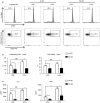Murine Sertoli cells promote the development of tolerogenic dendritic cells: a pivotal role of galectin-1
- PMID: 26878424
- PMCID: PMC4913288
- DOI: 10.1111/imm.12598
Murine Sertoli cells promote the development of tolerogenic dendritic cells: a pivotal role of galectin-1
Abstract
Sertoli cells (SCs) possess inherent immunosuppressive properties and are major contributors to the immunoprivileged status of mammalian testis. SCs have been reported to inhibit the activation of B cells, T cells and natural killer cells but not dendritic cells (DCs). Herein, we present evidence that co-culture with SCs results in a persistent state of DC immaturity characterized by down-regulation of the surface molecules I-A/E, CD80, CD83, CD86, CCR7 and CD11c, as well as reduced production of pro-inflammatory cytokines. SC-conditioned DCs (SC-DCs) displayed low immunogenicity and enhanced immunoregulatory functions, including the inhibition of T-cell proliferation and the promotion of Foxp3(+) regulatory T-cell development. Mechanistically, the activation of p38, extracellular signal-regulated kinase 1/2, and signal transducer and activator of transcription 3 was suppressed in SC-DCs. More importantly, we demonstrate that galectin-1 secreted by SCs plays a pivotal role in the differentiation of functionally tolerogenic SC-DCs. These findings further support the role of SCs in maintaining the immunoprivileged environment of the testis and provide a novel approach to derive tolerogenic DCs, which may lead to alternative therapeutic strategies for the treatment of immunopathogenic diseases.
Keywords: Sertoli cells; co-culture; dendritic cells; galectin-1; immune tolerance.
© 2016 John Wiley & Sons Ltd.
Figures






Similar articles
-
Cell-extrinsic CTLA4-mediated regulation of dendritic cell maturation depends on STAT3.Eur J Immunol. 2014 Apr;44(4):1143-55. doi: 10.1002/eji.201343601. Epub 2014 Jan 22. Eur J Immunol. 2014. PMID: 24338929
-
Novel immunomodulatory effects of adiponectin on dendritic cell functions.Int Immunopharmacol. 2011 May;11(5):604-9. doi: 10.1016/j.intimp.2010.11.009. Epub 2010 Nov 19. Int Immunopharmacol. 2011. PMID: 21094289
-
Galangin treatment during dendritic cell differentiation confers tolerogenic properties in response to lipopolysaccharide stimulation.J Nutr Biochem. 2021 Jan;87:108524. doi: 10.1016/j.jnutbio.2020.108524. Epub 2020 Oct 9. J Nutr Biochem. 2021. PMID: 33039583
-
Tolerogenic dendritic cells in the control of autoimmune neuroinflammation: an emerging role of protein-glycan interactions.Neuroimmunomodulation. 2010;17(3):157-60. doi: 10.1159/000258712. Epub 2010 Feb 4. Neuroimmunomodulation. 2010. PMID: 20134191 Review.
-
Recent discoveries in dendritic cell tolerance-inducing pharmacological molecules.Int Immunopharmacol. 2020 Apr;81:106275. doi: 10.1016/j.intimp.2020.106275. Epub 2020 Feb 7. Int Immunopharmacol. 2020. PMID: 32044665 Review.
Cited by
-
Sertoli Cell Immune Regulation: A Double-Edged Sword.Front Immunol. 2022 Jun 9;13:913502. doi: 10.3389/fimmu.2022.913502. eCollection 2022. Front Immunol. 2022. PMID: 35757731 Free PMC article. Review.
-
Galectin-1 and galectin-3 in male reproduction - impact in health and disease.Semin Immunopathol. 2025 Jan 2;47(1):6. doi: 10.1007/s00281-024-01032-7. Semin Immunopathol. 2025. PMID: 39792160 Free PMC article. Review.
-
Immune Regulation in the Testis and Epididymis.Adv Exp Med Biol. 2025;1469:25-47. doi: 10.1007/978-3-031-82990-1_2. Adv Exp Med Biol. 2025. PMID: 40301251 Review.
-
Isolation of Pig or Rodent Sertoli Cells for Use in Transplantation.Methods Mol Biol. 2025;2954:163-182. doi: 10.1007/978-1-0716-4698-4_8. Methods Mol Biol. 2025. PMID: 40601274
-
Infectious, inflammatory and 'autoimmune' male factor infertility: how do rodent models inform clinical practice?Hum Reprod Update. 2018 Jul 1;24(4):416-441. doi: 10.1093/humupd/dmy009. Hum Reprod Update. 2018. PMID: 29648649 Free PMC article. Review.
References
-
- Head JR, Neaves WB, Billingham RE. Immune privilege in the testis. I. Basic parameters of allograft survival. Transplantation 1983; 36:423–31. - PubMed
-
- De Cesaris P, Filippini A, Cervelli C, Riccioli A, Muci S, Starace G et al Immunosuppressive molecules produced by Sertoli cells cultured in vitro: biological effects on lymphocytes. Biochem Biophys Res Commun 1992; 186:1639–46. - PubMed
-
- Bistoni G, Calvitti M, Mancuso F, Arato I, Falabella G, Cucchia R et al Prolongation of skin allograft survival in rats by the transplantation of microencapsulated xenogeneic neonatal porcine Sertoli cells. Biomaterials 2012; 33:5333–40. - PubMed
Publication types
MeSH terms
Substances
LinkOut - more resources
Full Text Sources
Other Literature Sources
Molecular Biology Databases
Research Materials

